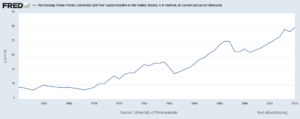February 01, 2024
The Washington Post ran a piece by Georgetown University professor Erwin Tiongson telling readers that to find out about the state of the world economy, look at the bottom of toy cars. The point was that toy cars are produced by a relatively simple manufacturing process. The countries that manufacture these cars are likely to have large supplies of relatively low-cost labor.
These countries often are seeing rapid growth as workers are shifting from agriculture to manufacturing, but are not wealthy, since they have large numbers of workers doing cheap labor. The article points out that seventy years ago, it would been common to see these cars produced in the United States. Then they were produced in Japan and Korea. As these countries became wealthier, they were no longer a source for cheap labor, instead China was a likely manufacturer.
With China getting wealthier, and more recently political efforts to reduce dependency on China, Tiongson said that he expected production to move to poorer countries like Mexico, Bangladesh, or Ethiopia. He said that he was surprised to find that many cars were being made in China and also Malaysia.
Tiongson then tells readers:
“In addition, toy manufacturing reflects not only the promise of industrialization but also its disappointments. In late 2022, Mattel commemorated its 40th year of manufacturing in Malaysia by announcing the growth of its Hot Wheels factory there, the world’s biggest. This was a positive development, but Malaysia’s economy reached middle-income status decades ago; in the familiar pattern, it would by now have progressed to manufacturing more complex, profitable products. Instead, the country has remained in what economists Indermit Gill and Homi Kharas defined as the “middle-income trap” — caught between developing and rich nations.”
Actually, the evidence does not indicate Malaysia is in a middle-income trap. Per capita income in Malaysia has continued to catch up rapidly with income in the United States and other wealthy countries, as shown below.

Its current level of per capita GDP is less than 7.0 percent below that of Greece, which would make most people’s list of wealthy countries. It also continues to maintain a rapid pace of growth. The I.M.F. recently projected its growth for 2023 at 4.0 percent, following 8.7 percent growth in 2022. It is projected to continue to grow at roughly a 4.0 percent rate for the rest of the I.M.F. projection period. With population growth of roughly 1.0 percent, this translates into 3.0 percent per capita GDP growth, implying that incomes would double in just over twenty years.
The I.M.F. projections could well prove to be wrong, but they certainly do not support the case for Malaysia being in a middle-income trap. For whatever reason, despite now being a relatively wealthy country, Malaysia is still exporting low-cost manufactured goods. Perhaps looking at the bottom of toy cars doesn’t tell us as much about the world economy as Mr. Tiongson claims.







Comments